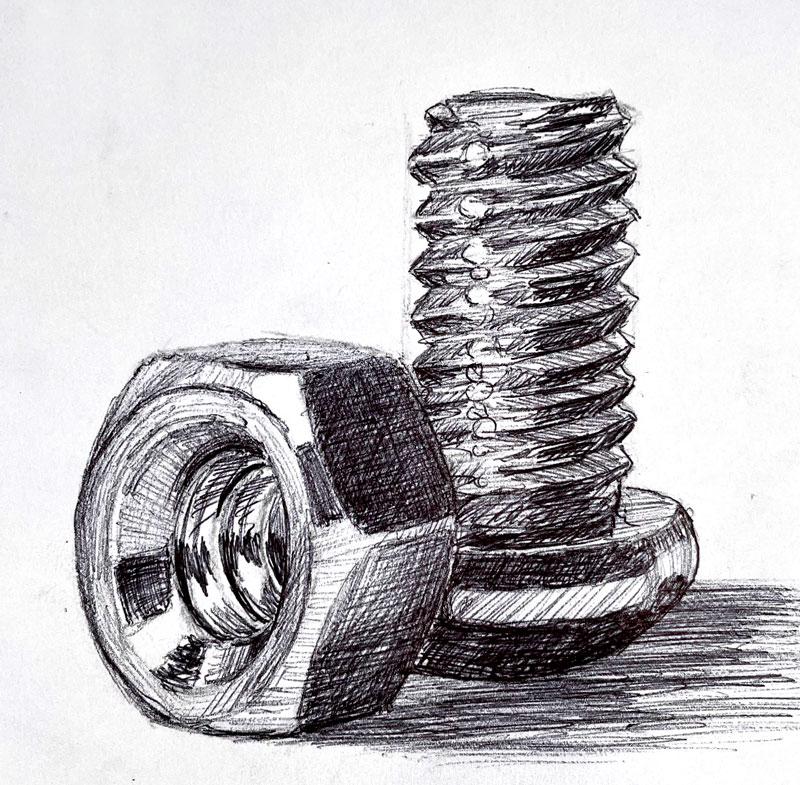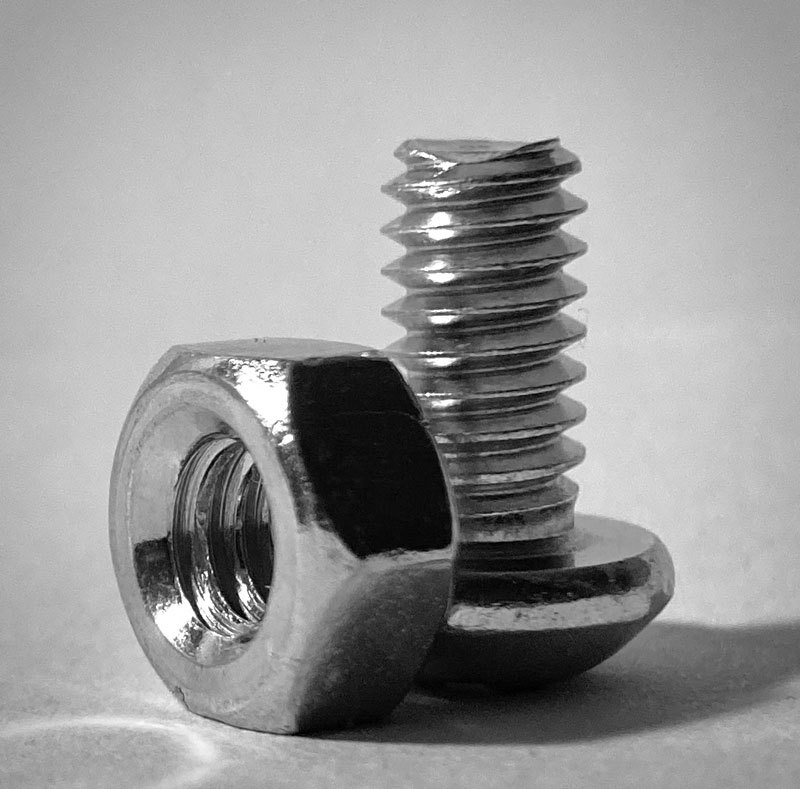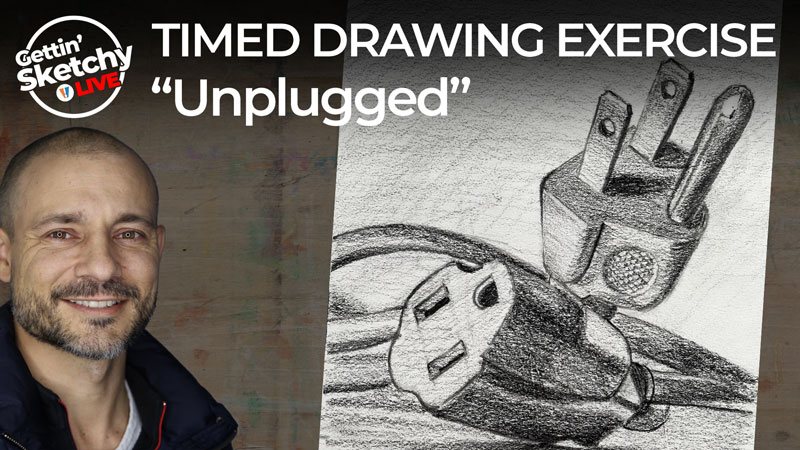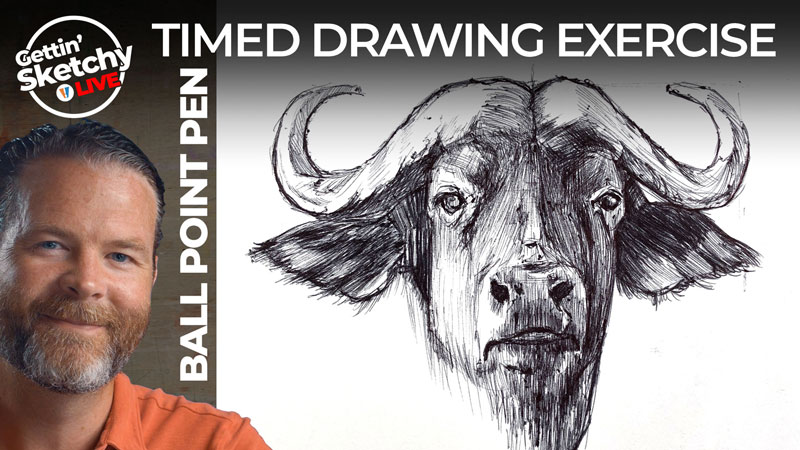Gettin’ Sketchy – Drawing Nuts and Bolts with a Ball Point Pen – Season 4 Episode 4
This episode aired live on YouTube on June 23, 2021.
Sometimes the best subjects for sketching are simply lying around us. Subjects such as tools or hardware provide us with drawing challenges that force us to look closely and problem solve. Nuts and bolts certainly fall into this category. These small fasteners feature complex details enveloped in basic shapes and forms.
In this sketching exercise, Ashley creates a drawing of a simple nut and bolt on white drawing paper with a basic ball point pen. This quick sketch is a great example of how inexpensive tools like a ball point pen can be used to create a developed sketch.
Here’s a look at the completed drawing…

Constructing the Sketch
We have a natural tendency to look for the lines when we begin a drawing. While we can clearly develop a drawing in this manner, there is a better, quicker, and more accurate way to approach drawing. When we start with the lines, we often run into proportional issues and produce less accurate drawings.
Instead of starting with the lines, we should consider looking for a different element of art – the shapes. We can build a drawing by stacking and combining shapes before shifting focus to the lines. This leads to greater accuracy in our drawings and also increases our speed.
This approach to drawing is often called construction and can be applied to any subject.
See also: Drawing Basics – Construction
Construction works by breaking complex objects down into basic shapes like circles, ellipses, rectangles, triangles, etc. These basic shapes are lightly drawn first, creating a framework for future marks.
As the drawing develops and the spacial relationships of the subjects are solidified within the picture plane, the details and the contour lines can be added confidently.
He begins with the ellipse found on the nut and then builds a structure outward from there. Another clear example of how construction is utilized is how he uses a rectangle to define the overall shape of the bolt before “carving” out the threads.
With this approach, Ashley is able to concentrate on the larger shapes and then gradually develop the details and smaller shapes within the larger ones. This allows him to work quickly without sacrificing accuracy.
Shading with a Ball Point Pen
Ashley first constructs the drawing with a graphite pencil. He begins with a pencil so that any mistakes can be correctly easily before committing with ink.
Once he is confident in the structure he’s created with the pencil sketch, he begins layering the ball point pen applications.
The ball point pen is quite unique when used as an art making tool. Unlike traditional drawing pens, a ball point pen can be used to create different values and intensities based on the amount of pressure placed on the pen.
Traditional pens used for drawing require the artist to work the concentration of marks in combination with the white of the paper to produce different values. While ball point pens can be used in this same manner, they also allow the artist to vary the pressure to produce grays like we can with a pencil.
See also: Basic Pen and Ink Techniques
This means that a ball point pen falls somewhere in between a graphite pencil and a traditional drawing pen. This allows the artist work the drawing as a traditional pen and ink drawing and/or as graphite drawing. While this sounds quite exciting, one obvious drawback is the lack of permanence of the medium.
When exposed to light over time, ball point ink will fade. Many artists that have embraced the ball point pen as a serious art making medium look for archival or acid-free inks but there is still no guarantee that these inks will last.
Materials for this Exercise
You likely already have the materials used in this drawing exercise. Basic white drawing paper, like you may find in a typical sketchbook, is used along with a HB graphite pencil and an inexpensive ball point pen.
Photo Reference
A reference image was used for this lesson. The reference image was photographed by Ashley after carefully positioning the objects into a pleasing composition.
Here’s a look at the photo reference…

Nuts and Bolts – Timed Drawing Exercise – Conclusion
The most basic subjects often make some of the best subjects when it comes to sketching practice. And while a couple of fasteners like a nut and bolt may seem like an odd subject, there are plenty of challenges there. Subjects like these are also great for larger, finished artworks as well.
Ultimately, when you practice – you improve. The subject that you choose to sketch is largely unimportant. Every subject presents challenges and forces you to problem solve, take chances, and exploit the medium. The more that you draw, and face these challenges, the faster you will improve.
If so, join over 36,000 others that receive our newsletter with new drawing and painting lessons. Plus, check out three of our course videos and ebooks for free.





